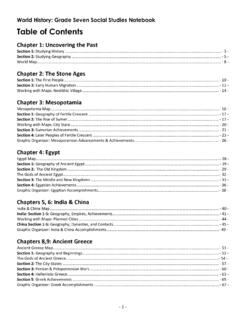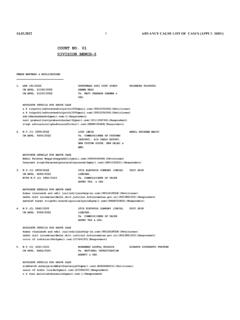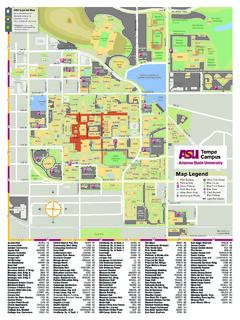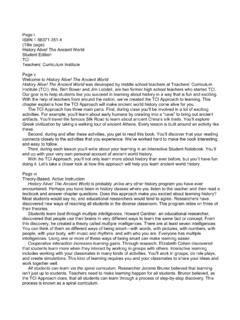Transcription of PowerPoint Presentation - Ancient India - Weebly
1 Ancient India An Overview Introduction The Big Idea Indian civilization first developed on the Indus River. Main Ideas The geography of India includes high mountains, great rivers, and heavy seasonal rain. Harappan civilization developed along the Indus River. The Aryan invasion of India changed the region s civilization. Basic chronology c. 3000 BCE: farming settlements appear along the valley of the river Indus in what is now Pakistan c. 2500 BCE: high point of the Indus Valley civilization c. 2000 BCE: some Indus sites showing signs of decline c. 1500 BCE: the Aryan invasions Timeline Geography of India India is a subcontinent, separated from the rest of the Asian continent by the Himalayas.
2 India can be divided in two, the northern plains, a flat low plain and the Deccan, a land with many hills. In northwest India is the Thar Desert. The Himalayas provided natural protection from northern invasions. The Indian Ocean and the Arabian Sea provided protection for the west and the east. FYI Historically, India s geographic boundaries were bigger than they are today Bangladesh + India + Pakistan = India Bangladesh and Pakistan did not exist as separate countries until after India gained independence from Great Britain in 1947 Northwest India generally means Pakistan Ancient Indian cities, such as Harappa and Mohenjo-daro, are located in what is now Pakistan Indian Geography The Indus Valley The Indus River is located in Pakistan.
3 Find it on the map. It was along this river that a civilization developed around 2,500 BCE. It is called the Indus Valley Civilization. Two major cities of this civilization were Harappa and Mohenjo-Daro. The River System The main river in Ancient India was the Indus River. The Indus River deposited fertile soil during annual flooding. The source of the Indus River is in the Himalayas. Indus Valley Culture The people of the Indus Valley were mostly peaceful farmers. They built large cities with ordered streets and bricks made all the same size. This indicates they had a strong central government. This statue is probably a priest or king. Indus Valley civilization Archaeologists discovered two 4000-year-old cities, 400 miles apart, along the banks of the Indus River in Pakistan.
4 These expertly constructed cities were parts of an advanced civilization comparable to Ancient Mesopotamia and Egypt. We don't know what the Ancient people of the Indus River Valley called themselves. Archaeologists named the cities Mohenjo-Daro, which means "hill of the dead," and Harappa, after a nearby city. Here is a reconstruction of what the entrance to Mohenjo Daro might have looked like. Indus Valley civilization Right: artist s recreation of Mohenjo-Daro Below: Great Bath ruins Mohenjo-Daro and Harappa The people of Mohenjo-Daro and Harappa lived in sturdy brick houses with as many as three floors. The houses had bathrooms that were connected to sewers. Their elaborate drainage system was centuries ahead of their time.
5 Archaeologists have found the remains of fine jewellery, including stones from far away places. This shows that the people of the Indus Valley civilization valued art and traded with other cultures. Mohenjo-Daro The Indus Valley built walls around their cities which indicated that they might have had to defend themselves against other people. We do not know a lot about them because we cannot yet read their writing. Everyday life Mysterious signifiers Examples of the multitude of Harrapan clay seals whose meaning(s) still elude us. Indus Valley Script Here are several examples of Indus Valley writing. It is believed that the Indus Valley people may have also written on palm leaves or cloth but no evidence of this has survived.
6 Indus Valley civilization We don't know what happened to the Indus River Valley civilization. It seems to have been abandoned about 1700BC. It is possible that a great flood weakened the civilization. The moving tectonic plates that created the Himalayas may have caused a devastating earthquake. It is also possible that the people may have been defeated by another culture. Aryan invaders Around 1500 BCE, a group of nomadic warrior-herders crossed the narrow Khyber Pass in the Hindu Kush Mountains and invaded the Indus Valley culture. These people, the Aryans, came from Eastern Europe between the Black Sea and Caspian Sea, probably looking for pastures for their animals. Flooding and earthquakes had weakened the Indus Valley culture and they were unable to withstand the newcomers.
7 Two cultures combine Below: an illustration of a scene from the Rig-Veda The Aryans brought with them their own language, called Sanskrit and religious and cultural beliefs. The Indus Valley people eventually became intermixed with the Aryan people and the two cultures together make up what is now much of the culture of modern India . Hinduism, the major religion of India , was a mixture of Aryan and Indus Valley beliefs. The caste system, which keeps people in strict social classes, was brought to India by the Aryans. Sanskrit Origins of Hinduism The Big Idea Hinduism, the largest religion in India today, developed out of Ancient Indian beliefs and practices. Main Ideas Indian society divided into distinct groups under the Aryans.
8 The Aryans practiced a religion known as Brahmanism. Hinduism developed out of Brahmanism and influences from other cultures. The Jains reacted to Hinduism by breaking away to form their own religion. Hinduism The Aryans and the Indus Valley culture eventually produced what is known today as Hinduism. This religion is polytheistic, which means believing in many gods. We know about this Ancient religion because of Aryan books called Vedas that record the beliefs of the Aryans. Pictured here is one of the many gods of Hinduism, Krishna. Alien gods and values Below: Brahma, Vishnu, and Shiva Right: the monkey god Hinduism Hinduism differs from other religions like Christianity, Judaism and Islam in that there is no one single founder or one set of beliefs that must be followed.
9 There are thousands of Hindu gods and goddesses in Hinduism. Most of the beliefs of Hinduism came from the oral traditions of the Aryans which became the Vedas or holy writings of the Hindus. Jains react to Hinduism Origins of Jainism 599 BC, established as an alternative to Hindu ritualism Based on the teachings of Mahavira, who abandoned his life of luxury to become a monk Four principles of Jainism Injure no life ahimsa (non-violence) Tell the truth Do not steal Own no property Jain saint Caste system One social custom brought to India by the Aryans was the caste system. This system put every person in society into a certain class from which they could never advance. The caste system was very effective in keeping social order but it was rigid and strict.
10 Those in the lowest caste were looked down on by upper caste members and could never change castes. Caste system Top Caste Brahmins priests Second Caste Kshatriyas rulers, landowners and warriors Third Caste Vaishyas Farmers, craftspeople, and traders Forth Caste Sudras not Aryan, great part of the Indian population Peasants, artisans/manual labour The Untouchables panchamas performed dirty/menial jobs Caste system Vaishyas Kshatriyas The Untouchables Brahmins at prayer Sudras Buddhism The Big Idea Buddhism began in India and became a major religion. Main Ideas Siddhartha Gautama searched for wisdom in many ways. The teachings of Buddhism deal with finding peace.







